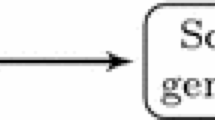Abstract
We will propose a new method for constructing an optimal portfolio in which the fund is allocated to assets and currencies of several countries. Traditionally, two or three stage method is adopted in this field. However, it neglects the risk associated with variations of the rate of return of individual assets and the exchange rate of currencies. Instead, the new method enables one to simultaneously determine the optimal amount of fund to be allocated to each asset and the amount of the forward contracts on currencies. The resulting optimization problem is apparently a nonconvex minimization problem due to the existence of product terms in the objective function. We will show, however, that a globally optimal solution can be calculated by a standard algorithm in an efficient way. Also we will demonstrate that the new method leads to a substantially better result using historical data of U.S., Japan and Germany.
Similar content being viewed by others
References
Adler, M. and Dumas, B. (1983), International portfolio choice and corporation finance: A synthesis, J. of Finance 38, 925–984.
Adler, M. and Jorion, P. (1992), Universal currency hedges for global portfolios. J. of Portfolio Management, 28–35.
Black, F. (1989), Universal hedging: How to optimize currency risk and reward in international equity portfolios, Financial Analyst Journal.
Black, F. and Litterman, R. (1992), Global portfolio optimization, Financial Analyst Journal.
Merzrich, J.J., Sorensen, E.C. and Thadani, D.N. (1993), Currency hedging through portfolio optimization. J. of Portfolio Management.
Eun, C.S. and Resnick, B.G. (1984), Estimating the correlation structure of international share prices, J. of Finance 39, 1311–1324.
Eun, C.S. and Resnick, B.G. (1988), Exchange rage uncertainty, forward contracts, and international portfolio sclection, J. of Finance 43, 197–215.
Grauer, R.R. and Hakansson, N.H. (1987), Gains from international diversification: 1968–85 returns of portfolios of stocks and bonds, J. of Finance 42, 721–741.
Hauser, S. and Levy, A. (1991), Optimal forward coverage of international fixed-income portfolios, J. of Portfolio Management, 54–59.
Hilliard, J.E. (1984), Hedging interest rate risk with futures portfolios under term structure effects, J. of Finance 39, 1547–1569.
Jorion, P. (1985), International portfolio diversification with estimation risk, J. of Business 58, 259–278.
Konno, H. and Yamazaki, H. (1991), A mean-absolute deviation portfolio optimization model and its applications to tokyo stock market, Management Science 37, 519–531.
Konno, H. and Kobayashi, K. An integrated stock-bond portfolio optimization model, to appear in J. of Economic Dynamics and Control.
Konno, H. and Suzuki, K. (1992), A fast algorithm for solving large scale mean-variance models by compact factorization of covariance matrices, J. of the Operations Research Society of Japan 35, 93–104.
Kritzman, M. (1993), The optimal currency hedging policy with biased forward rates, J. of Portfolio Management, 94–100.
Markowitz, H.M. (1959), Portfolio Selection: Efficient Diversification of Investments, John Wiley and Sons, Inc.
Mulvey, J.M. and Ziemba, W.T. (1995), Asset liability and allocation in a global environment, in R.A. Jarrow, V. Maksimovic and W.T. Ziemba, (eds), Finance, Handbooks in Operations Research and Management Science 9, 435–464. Elsevier Science B.V.
Nakasato, M. and Furukawa, K. (1993), On the number of securities which constitute an efficient portfolio, Annals of Operations Research, 45, 333–347.
Shinozaki, M. (1996), Global asset alocation with optimal allocation of currencies (in Japanese), JAFEE Journal, 3–19.
Smith, C.W. and Stulz, R.M. (1985), The determinants of firms' hedging policies, J. of Financial and Quantitative Analysis 20, 391–405.
Solnik, B. (1991), International Investments: 2nd ed. Addison-Wesley.
Stulz, R.M. (1984). Optimal hedging policy, J of Financial and Quantitative Analysis 19, 127–140.
Author information
Authors and Affiliations
Rights and permissions
About this article
Cite this article
Suzuki, KI., Konno, H. & Morjiri, M. An International Portfolio Optimization Model Hedged with Forward Currency Contracts. Asia-Pacific Financial Markets 4, 275–286 (1997). https://doi.org/10.1023/A:1009656805019
Issue Date:
DOI: https://doi.org/10.1023/A:1009656805019




